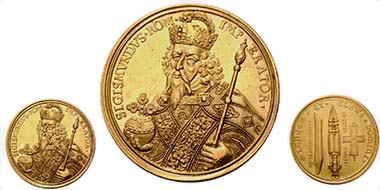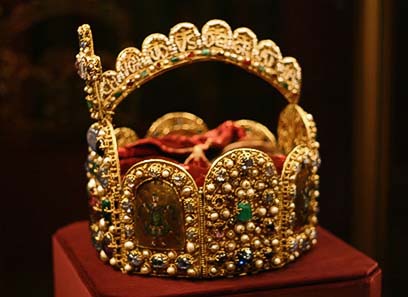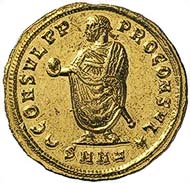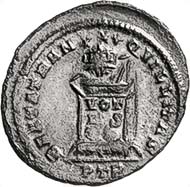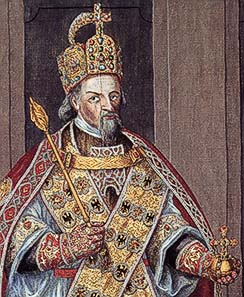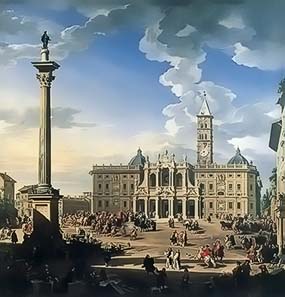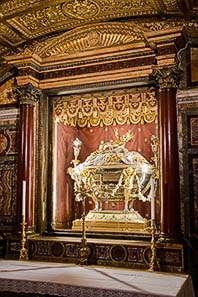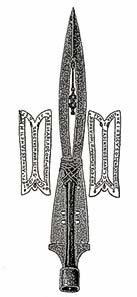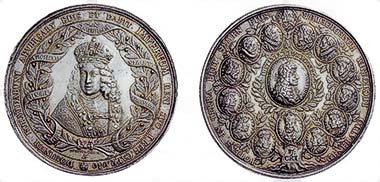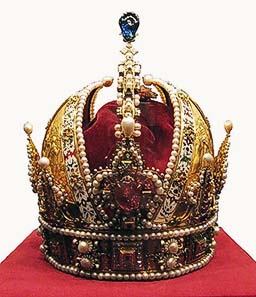Since 1424, the so-called Heiltumsweisung (Festival of Relics) was held each year in Nuremberg. On that occasion, the Imperial Regalia were taken out of the treasure chamber and presented to the crowds of people who had travelled to Nuremberg just to get a glimpse of it. The Heiltumsweisung was a church ceremony since the objects shown were – wrongly, to some extent – connected with Charles the Great who was canonised in 1165. Because of that, they were not only considered symbols of the Holy Roman Empire but salutary relics as well. A medal without date (around 1700) made by M. Brunner depicts the most important elements of this treasure.
Fig. 1: NUREMBERG. Gold medal of 6 ducats. Half-length portrait of Sigismund wearing the Coronation Vestment of the Holy Roman Emperor. Rev. Imperial Regalia. 20.76 g. Erlanger Coll. 1064. From auction sale Hess-Divo AG 301 (2005), 242.
On the obverse Sigismund, Holy Roman Emperor, is shown (*1368, German King 1410, Emperor 1433, +1437). It was he who, in 1424, gave the order to keep the Imperial Regalia in Nuremberg. On our medal this emperor that was so important for Nuremberg is clad in the coronation vestment traditionally worn by the kings of the Holy Roman Empire.
Those who had come to Nuremberg on the occasion of the Heiltumsweisung could admire many of these vestments first-hand. There is no need to envy these people since today a direct comparison is still possible. Most parts of the coronation vestments and the Imperial Regalia are preserved and on display at the Treasury in the Hofburg Imperial Palace in Vienna.
Fig. 2: Crown of the Holy Roman Empire.
Highlight of the exhibition and eye catcher of this medal is, of course, the Imperial Crown Sigismund is wearing. Presumably the crown was made on the occasion of the coronation of Otto the Great in 962. Every single detail of this peculiar headgear has a symbolic character of its own. Its octagonal shape, for instance, refers to the eight as the number of perfection who was claimed for the emperor as the royal number. The gold, with its adornment made of gemstones and beads which our medal indicates to, refers to the idea of Heavenly Jerusalem that in the Middle Ages was thought to be built entirely from gold and adorned with jewellery and beads. The clearly visible strip was made later than the ring. It was added under Conrad II (1024-1039), just like the small cross above the forehead that dates to the reign of Henry II (1002-1024).
In his hand Sigismund holds the Imperial Orb. In Nuremberg three examples of that Orb were kept once of which two were lost when the treasures were rescued from the approaching Napoleonic troops. Only one out of three Imperial Orbs is preserved. Probably it was made in Cologne around 1200 and, as image of the universe, refers to the idea of world domination.
Fig. 3: MAXIMINUS II DAIA, 310-313. Aureus, Antiochia, 311. Rev. The Emperor clad in a consular mantle with a short sceptre standing to the left with a globe in his outstretched hand. 5.31 g. RIC 127avar. From auction sale Leu Numismatik 87 (2003), 111.
Fig. 4: CONSTANTINUS II, 337-340. Follis, Trier, 321. Laureate bust with globe to the left, on the globe Victoria crowning the Emperor. Rev. Altar with the inscription VOTIS XX, globe on top of it. RIC – (cf. 312). 2.64 g. From auction sale Numismatik Lanz 100 (2000), 560.
The concept to visualise the dominion of the entire then known world by means of depicting the Emperor with a golden image of the universe dates back to Antiquity.
Especially in late Imperial Times many Roman coins were created depicting globes: either the emperor holds them in his hands, receives them from his patron deity or they lie on altars and thereby allude to the vows that the emperor took to the preservation of his rule for the next five years.
It is possible that the depiction on our medal hints at the preserved Imperial Orb. However, depiction and original differ in one significant detail: the cross straps of the real object lead all around the sphere whereas on the medal they cover only the upper half of it. On the preserved object, however, these cross straps are gemmed only halfway through; the chased lower half is hardly visible at all what the die cutter of the medal possibly illustrated by omitting the lower part.
Close inspection of the medal reveals that the hands of our Emperor Sigismund are decorated. Again, there is ceremonial reason for that. The king covered his hands with gloves so as to avoid any direct contact with the sacred, the Imperial Regalia. That was a sign of reverence for the divine that still lives on in the Catholic service of the present day: when lifting the monstrance, the priest carefully covers his hands with a cloth. Very special gloves were reserved for the coronation. They were made of red purple and lavishly adorned with gemstones and beads. Probably Sicilian craftsmen had produced these gloves on the occasion of the coronation of Frederick II in 1220. Likewise from Sicily the Coronation Mantle came that Sigismund is wearing on this medal. This garment can be identified only by the typical border showing alternately a rhomb and a quatrefoil. The mantle must not be confused with the stole that the emperor has wrapped cross-over his upper body. It is too long to be worn like a priestly stole, i. e. put around the neck with both ends hanging downwards. It more likely that the stole was manufactured in the style of the loros the Byzantine Emperors continued to wear.
Discernible are the actually existing medals where crosses alternate with depictions of eagles.
Fig. 5: Emperor Sigismund with the Imperial Regalia.
In his left hand Sigismund holds a sceptre, a plain gold staff with arabesques at the end. This element is well known from depictions. The original most possibly got lost when the Imperial Regalia were translated.
Fig. 6: Santa Maria Maggiore.
Fig. 7: Reliquary of the church of Santa Maria Maggiore with the relics of Christ’s crib.
Whereas the obverse shows all important elements of the coronation ceremony the reverse depicts the relics that were considered the Empire’s most venerable ones. On the far left one can see a reliquary containing a splinter of the wood which the crib of Jesus Christ allegedly was made of. The Holy Roman Emperor Charles IV gave this then treasure to Pope Urban V as a present in 1368. At the behest of the Pope the splinter was cut from the crib that was venerated in the Roman basilica Santa Maria Maggiore (fig. 6 and 7). In those days, that was a present which in value exceeded any other gift a ruler could bring. The entire Christian world was striving after travelling to Rome to pray in front of Christ’s crib. Today, the value of this relic has depreciate in such a way that even good guide books do not mention its existence anymore when referring to the art treasures of the Eternal City.
Fig. 8: Holy Lance.
Far better known than the relic of Christ’s crib is the so-called Holy Lance. It is said that it contained one of the Holy Nails that had been used for the Crucifixion of Jesus Christ. Various traditions associated the Lance with the Emperor Constantine and Saint Maurice whose cult came to flourish under the Holy Roman Emperor Otto the Great. In the 13th century the Lance was thought to be the weapon of Longinus which he thrust into Christ’s side. As a matter of fact the piece dates back to the 8th century, the Carolingian time. The Holy Lance was the most important of all the Empire’s relics.
Our medal takes that fact into account. The Lance is depicted right in the middle of the three relics, on the spot the protocol reserves for the one of the highest rank. Still in the Early Modern Times, this relic was worshipped to such an extent that the Emperor Charles IV won out over the Pope – a new feast day was introduced in the church calendar to commemorate both Lance and Nail.
To the right of the Holy Lance a plain cross is depicted which in Medieval Times also was regarded a treasure. A part of the True Cross was inserted here. According to Christian tradition, this ancient relic was found by Helena, the mother of Constantine, in the Holy Land. Legend has it that she – acting like a predecessor of modern archaeologists – had an archaeological excavation conducted on Golgatha Mountain that brought three crosses to light. One of these had to be the True Cross Christ had moistened with his blood. Helena put it to the test: she had three corpses brought and laid down, one on each cross; she wanted to see which one of the crosses would bring the deceased back to life – that one obviously was the True Cross. This treasure she brought with her to Constantinople where the Byzantine Emperor henceforth distributed small parts among contracting partners. It is possible, therefore, that the Emperor Romanos III handed our relic over to Conrad II in 1029. In doing so, the Byzantine Emperor relinquished something extraordinary that even gained in importance since it contained the hole of one of the Holy Nails used to crucify Jesus Christ. To the worshippers this was important and the artist took account of it: the hole in the wood of the cross is clearly visible in the depiction.
Fig. 9: HRE. Joseph I, 1705-1711. Huge dynasty medal 1690 by M. Brunner. Crowned half-length portrait of Joseph inside an olive wreath with a banderole. Rev. Genealogical tree with 15 medals of Hapsburg rulers. 124.00 g. Julius Coll. 524. From auction sale Hess-Divo AG 300 (2004), 1011.
But why do not all coins show the German King or the Emperor with the Imperial Crown of the Holy Roman Empire? Fig 9, for instance, depicts a whole series of Hapsburg rulers of which only one, Rudolf I, shown on the medal in the middle below, is wearing the Imperial Crown. The answer is simple. The Imperial Crown was kept in Nuremberg and used only for the coronation ceremony. But, every king or emperor needs a crown in everyday life. Hence, every ruler had his own crown made according to contemporary taste. Of these, only one has survived – displaying similarities to the one worn by Joseph I on our medal.
Fig. 10: Crown of Emperor Rudolf II.
The Holy Roman Emperor Rudolf II had the crown made as a then representational object without any constitutional function. That very function the crown gained only in 1804 when Francis I designated it as the Crown of the Austrian Empire although it was never used in any coronation ceremony.
All objects mentioned here can be viewed in the Treasury of the Hofburg Imperial Palace in Vienna. Anyone interested in coins will find the exhibition quite interesting. There, he will suddenly discover many objects in the original which he hitherto only knew from coin images.
Secular and Ecclesiastical Treasury
1. District, Vienna, Hofburg Imperial Palace, Swiss Courtyard.
Phone: +43 1 525 240; www.khm.at; info.kk@khm.at
Opening hours: Wed-Mon 10 am–6 pm; Entrance fee 8 Euros.
Audio guide (to be recommended): 2 Euros
http://www.khm.at/schatzkammer/





